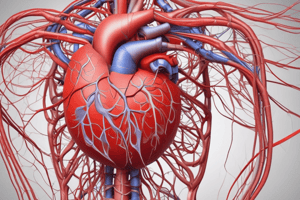Podcast
Questions and Answers
What is the function of the sympathetic neurotransmitters norepinephrine and epinephrine on heart rate?
What is the function of the sympathetic neurotransmitters norepinephrine and epinephrine on heart rate?
- Decrease heart rate
- Have no effect on heart rate
- Increase heart rate (correct)
- Maintain a constant heart rate
What is the main function of the parasympathetic neurotransmitter acetylcholine on heart rate?
What is the main function of the parasympathetic neurotransmitter acetylcholine on heart rate?
- Have no effect on heart rate
- Decrease heart rate (correct)
- Increase heart rate
- Maintain a constant heart rate
What is the direction of blood flow through vessels due to hydrostatic pressure?
What is the direction of blood flow through vessels due to hydrostatic pressure?
- From low pressure to high pressure
- It is static, with no net flow
- From high pressure to low pressure (correct)
- Randomly in all directions
What is the primary adaptation that allows giraffes to pump blood to their brains against gravity?
What is the primary adaptation that allows giraffes to pump blood to their brains against gravity?
What is the term for the slowing of blood flow through vessels to allow for greater exchange over a greater surface area?
What is the term for the slowing of blood flow through vessels to allow for greater exchange over a greater surface area?
What is the function of the smooth muscle layer in arterioles?
What is the function of the smooth muscle layer in arterioles?
What is the function of the SA node in the heart?
What is the function of the SA node in the heart?
What is the main difference between the circulatory systems of mammals and birds compared to amphibians and reptiles?
What is the main difference between the circulatory systems of mammals and birds compared to amphibians and reptiles?
What is the function of the AV node in the heart?
What is the function of the AV node in the heart?
Which type of circulatory system is present in fish?
Which type of circulatory system is present in fish?
What is the role of the Purkinje fibers in the heart?
What is the role of the Purkinje fibers in the heart?
What is the benefit of a four-chambered heart in mammals and birds?
What is the benefit of a four-chambered heart in mammals and birds?
What is the main function of the heart in the circulatory system?
What is the main function of the heart in the circulatory system?
In an open circulatory system, what is the fluid that directly surrounds organs?
In an open circulatory system, what is the fluid that directly surrounds organs?
What is the function of capillaries in the circulatory system?
What is the function of capillaries in the circulatory system?
What is the term for blood vessels that carry blood from capillaries to the heart?
What is the term for blood vessels that carry blood from capillaries to the heart?
What is the fluid that moves around in the circulatory system of a typical arthropod?
What is the fluid that moves around in the circulatory system of a typical arthropod?
What is the main difference between open and closed circulatory systems?
What is the main difference between open and closed circulatory systems?
Flashcards are hidden until you start studying
Study Notes
Circulatory Systems Overview
- Single circulation: blood passes once through the heart, seen in fish with a pulmocutaneous circuit involving lung and skin capillaries.
- Double circulation: blood passes through the heart twice, characteristic of mammals and birds, featuring a four-chambered heart.
- Amphibians and reptiles have partially separated ventricles, controlling oxygen-rich blood to lungs versus the body.
Heart Structure and Function
- Heart consists of right and left atria (A) and ventricles (V), facilitating separation of oxygenated and deoxygenated blood.
- Cardiac muscle cells are coordinated by pacemaker cells, specifically the sinoatrial (SA) node in the right atrium.
- Atrioventricular (AV) node connects atria and ventricles, allowing a delay for atrial emptying before ventricular systole.
Cardiac Cycle and Electrical Conduction
- The cardiac cycle is regulated by electrical signals: atrial systole is induced by cardiac action potentials.
- Purkinje fibers rapidly conduct signals to the heart apex, ensuring efficient contraction.
- Blood flows from the heart through vessels to all body cells, facilitating gas exchange, nutrient absorption, and waste removal.
Types of Circulatory Systems
- Open circulatory system: circulatory fluid (hemolymph) directly bathes organs, pumped by heart contractions; lacks separation from interstitial fluid.
- Closed circulatory system: blood is contained within vessels separate from interstitial fluid; exchanges occur at capillaries.
Vascular Structure and Blood Flow
- Blood vessels include arteries (carry blood away from heart), veins (return blood to heart), and portal veins (link between capillary beds).
- The total length of blood vessels in an average adult is double Earth's circumference at the equator, showcasing an extensive circulatory network.
- Blood pressure is regulated by sympathetic (increases heart rate) and parasympathetic (decreases heart rate) systems, influenced by hormones like norepinephrine and acetylcholine.
Blood Pressure and Velocity
- Human systolic pressure averages around 120 mmHg; giraffes experience significantly higher pressure (~250 mmHg) to deliver blood to the head.
- Blood velocity varies through the system, with highest in arteries (48 cm/sec) and significantly reduced in capillaries (0.1 cm/sec), allowing for greater nutrient and gas exchange.
Vessel Composition
- Arteries possess elastic connective tissue, allowing for stretch and recoil which maintains blood flow.
- Veins contain valves to prevent backflow, while smooth muscle in vessel walls regulates diameter through vasodilation and vasoconstriction.
- Capillaries are characterized by their small diameter (15 µm), facilitating easy exchange of materials with surrounding tissues.
Studying That Suits You
Use AI to generate personalized quizzes and flashcards to suit your learning preferences.




